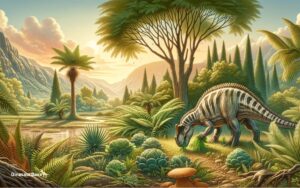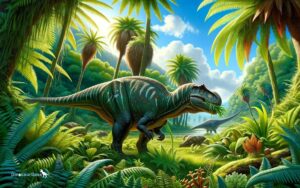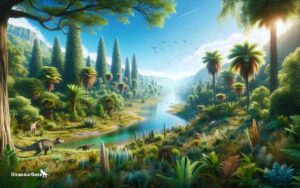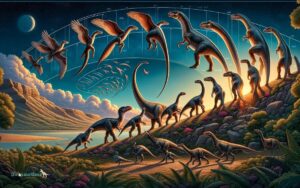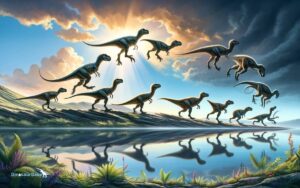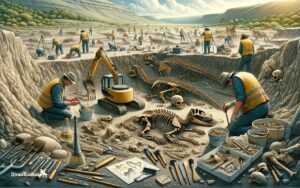5 Best Foods in Herbivorous Dinosaur Diets
The five best foods in herbivorous dinosaur diets include cycads, conifers, ferns, mosses, and ginkgoes. These plants provided the essential nutrients required for their survival.
Herbivorous dinosaurs thrived millions of years ago, roaming the vast landscapes that teemed with lush vegetation.
Their diets were primarily plant-based, ranging from towering coniferous trees to low-lying ferns and mosses. Cycads, resembling modern-day palms, served as a staple for these gigantic creatures.
They were rich in energy, ensuring these herbivores had the stamina needed to support their massive bodies. Ginkgoes, with their distinctive fan-shaped leaves, also featured prominently in their eating habits.
Such diversity in plant life not only sustained the various species of herbivorous dinosaurs but also played a critical role in their evolutionary journey.
As these ancient beasts grazed on the flora available to them, they shaped the prehistoric landscapes, influencing the ecology of their time.
Understanding their diets helps paleontologists uncover the mysteries of how these fascinating creatures lived and interacted with their environment.
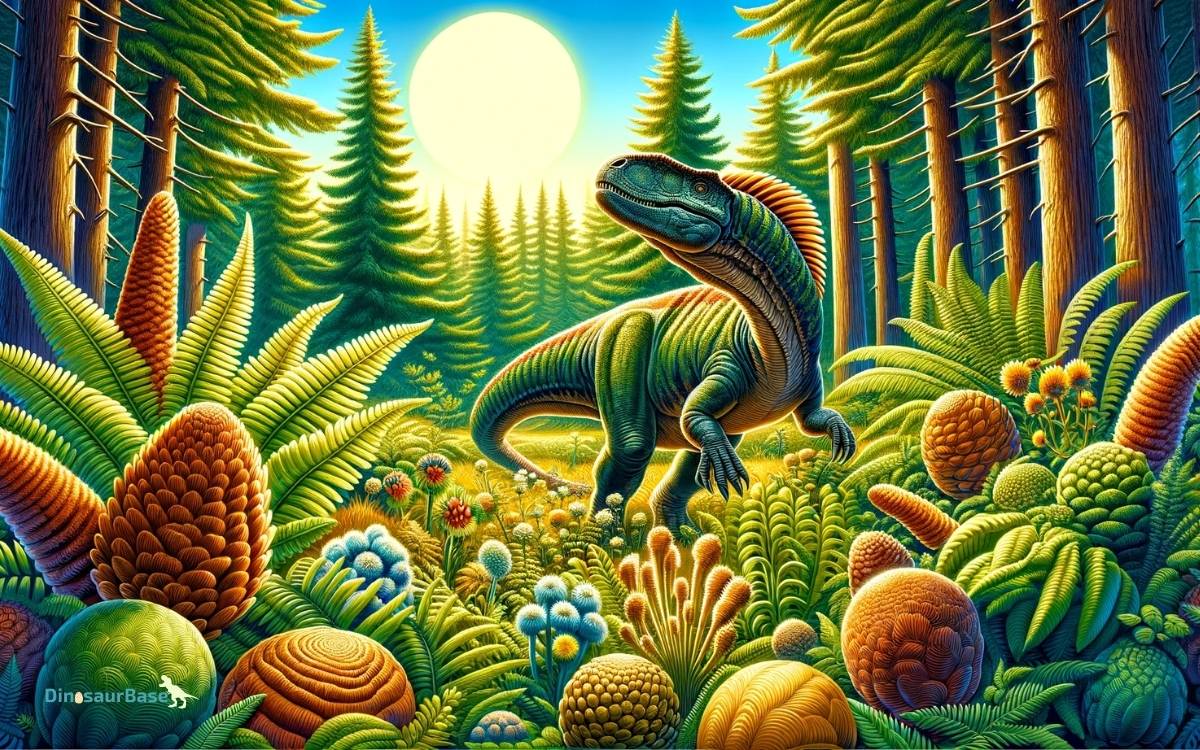
Prehistoric Gastronomy

Credit: www.mydinosaurs.com
The diets of massive, gentle giants that once roamed the Earth have fascinated scientists for decades.
As we explore the 5 Best Foods in Herbivorous Dinosaur Diets, a picture of prehistoric gastronomy comes to life. These creatures’ meals were quite different from the green salads we enjoy today!
Evolution Of Herbivorous Dinosaur Palates
Herbivorous dinosaurs adapted to their environments, developing unique eating habits. Through millions of years, their palates evolved, offering insights into ancient ecosystems.
- Cycads: Tough, palm-like plants that dinosaurs ground with strong jaw muscles.
- Ginkgoes: Nutrient-rich leaves that offered a seasonal feast.
- Horsetails: Bamboo-like plants that provided silica to help herbivores grind other foods.
- Conifers: Evergreen fare that sustained them year-round.
- Ferns: A common snack that scattered across the Cretaceous landscape.
Factors Influencing Dinosaur Diets
Dinosaur diets were shaped by many environmental factors. Their food choices reveal a lot about prehistoric flora.
| Factor | Impact on Diet |
|---|---|
| Location | Local plants dictated available food. |
| Season | Seasonal growth cycles influenced feeding patterns. |
| Body Size | Larger dinosaurs needed more food to sustain their size. |
| Teeth Structure | Teeth shape and strength limited the types of plants they could eat. |
| Competition | Dinosaurs ate different foods to avoid competition. |
Unearthing Dinosaur Dietary Preferences
Journey back millions of years to uncover the eating patterns of herbivorous dinosaurs.
What did these colossal creatures feast upon in their vast, prehistoric world?
Excavating fossils offers clues. Let’s dig into the top five foods that fueled these gentle giants.
Dental Evidence And Eating Habits
Dinosaurs’ teeth reveal secrets about their diet.
- Triceratops had teeth perfect for tough plants.
- Sauropods’ teeth suggest they munched on softer greens.
Each species had unique teeth to handle different foliage.
Fossilized Gut Contents Analysis
Fossilized remains bring the past to life. Scientists study these to guess different dinosaurs’ diets.
| Dinosaur | Likely Favorite Foods |
|---|---|
| Diplodocus | Conifers, ferns, and moss |
| Stegosaurus | Cycads and fruiting plants |
| Iguanodon | Ginkgoes and seed ferns |
| Brachiosaurus | High-canopy leaves and bushes |
| Hadrosaurids | Twigs, leaves, and pine needles |
Top Plant Sources For Mighty Sauropods
The diet of mighty sauropods, those colossal herbivores that walked the Earth millions of years ago, is a topic of both wonder and scientific intrigue.
With massive bodies and long necks, these ancient creatures needed a vast amount of plant food to sustain their energy.
Let’s explore the top plant sources that were likely the staples in the diets of these towering dinosaurs.
Coniferous Buffet: Pine Needles & Cones
Sauropods roamed in regions abundant with coniferous forests. These plants offered a nutrient-rich feast perfect for our large friends.
- Pine needles: Packed with fiber and easy to munch.
- Pine cones: A crunchy treat full of seeds.
The Fern Library: A Range Of Lush Varieties
With a soft texture and rich in energy, ferns were like the daily bread for sauropods. A diverse buffet, each species offered a different taste and nutritional profile.
| Fern Type | Nutritional Benefit |
|---|---|
| Cycad Ferns | High in starches |
| Horsetail Ferns | Loaded with minerals |
| Tree Ferns | Great for roughage |

Credit: www.mydinosaurs.com
Ornithopods’ Favorite Floras
The meadows and forests of the Mesozoic era brimmed with greenery, perfect for the grazing herbivorous dinosaurs known as Ornithopods.
These plant-eating giants thrived on an assorted menu. Each plant offered unique nutrients essential for their survival and well-being. Let’s delve into the two main types of flora that crowned the Ornithopods’ dietary choices!
Cycads: The Nutritional Powerhouses
Cycads stood out in the dinosaur world. These ancient plants were not just garden ornaments; they were the go-to meal for many Ornithopods.
High in fiber, they helped these dinos maintain a healthy digestive system. Their tough, palm-like leaves required strong jaw muscles to chew, perfect for Ornithopods’ robust dentistry.
Cornucopia Of Magnoliids And Angiosperms
Magnoliids and angiosperms were the next favorites on the Ornithopods’ plate. These flowering plants and their relatives provided a vast banquet for the senses.
Rich in color and bursting with nutrients, these plants were not just a feast for the eyes but a bonanza of nourishment.
The diversity in this group offered Ornithopods an enviable array of flavors and textures, ensuring a balanced diet.
Stegosaurs And Their Thorny Delights
The Stegosaurus, a plant-eating giant from the past, spends its days munching on a variety of greens.
These magnificent creatures had a diet comprising tough, fibrous plants. Discover what was on the menu for these ancient beasts!
Gnawing On Ginkgos: A Tough Bite To Swallow
The ginkgo tree stood the test of time, just like our tough-toothed Stegosaurus. With leaves hard to tear, this tree provided a resilient snack for these beasts.
Let’s explore what made ginkgos a staple in the Stegosaurus diet:
- Rich in nutrients: Important for the herbivorous giant’s health.
- Fibrous leaves: Ideal for their grinding teeth.
- Abundance: Ginkgos grew plentifully in the dinosaur era.
Browsing Thistles And Shrubs Strategically
Stegosaurs selected their food with care. They favored thistles and shrubs, despite their sharp defenses.
Here’s why these plants were perfect for their diet:
| Plant Type | Benefits |
|---|---|
| Thistles | Offering high nutritional value and easy accessibility. |
| Shrubs | Dense in energy; crucial for maintaining their large size. |
What Role Did Plant-Based Foods Play in the Diets of Early Dinosaurs?
Plant-based foods were a crucial part of exploring early dinosaur habitat. The diets of early dinosaurs consisted mainly of ferns, horsetails, and other plant materials. These plant-based foods provided the necessary nutrients for their survival and played a significant role in their overall diet and evolution.
What Are the Similarities in Herbivorous Dinosaur Diets Across Different Species?
Herbivorous dinosaur diets were relatively consistent across different species. The best early jurassic foods consisted of ferns, cycads, and conifers, which provided a high fiber, low-calorie diet. This diet allowed herbivorous dinosaurs to sustain their large bodies and grow to massive sizes over time.
Impacts Of Dinosaur Grazing Patterns
The way herbivorous dinosaurs ate had big effects on their world. These giants ate lots of plants. They changed the land and helped new plants grow. Let’s dig into this prehistoric tale!
Shaping The Prehistoric Landscape
Giant dinosaurs eating made the ancient world look different. Picture huge, hungry dinosaurs roaming around. They ate tons of plants every day.
This eating cleared spaces in forests. It made room for new plants to grow. Open fields appeared where there were once thick trees. This helped small creatures find homes and food.
These ancient animals acted like nature’s gardeners. Some ate the tops of trees. Others munched on tough bushes. All this grazing trimmed the plants. It kept the landscape healthy and full of variety.
Co-evolution With Plant Life
Plants and dinosaurs grew up together. The plants that dinosaurs liked to eat lived better. They grew back fast after being eaten.
The ones that dinosaurs didn’t eat much might have stopped growing around. So, dinosaurs eating plants made the plants change over time too.
Let’s picture a certain type of fern. Dinosaurs loved it. This fern began to grow in many places. It became really good at getting better after being eaten. So, plants and dinosaurs helped each other live and change.
Dinosaurs and their diets had a big effect on Earth long ago. They made the land diverse and helped plants change to survive better. This story of giant eaters is a fascinating part of our planet’s history.
Conclusion
Exploring the diets of ancient herbivorous dinosaurs offers fascinating insights into prehistoric life. These five foods—cycads, conifers, ginkgoes, ferns, and horsetails—provided the nutrition needed to support these giants.
Embracing our planet’s history enriches our understanding of biodiversity and evolution. So, let’s keep digging into the past for a better grasp of the natural world!

